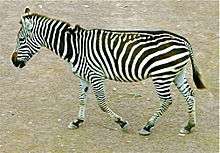Quadrupedalism
Quadrupedalism is a form of terrestrial locomotion in animals using four limbs or legs. An animal or machine that usually moves in a quadrupedal manner is known as a quadruped, meaning "four feet" (from the Latin quattuor for "four" and pes for "foot"). The majority of quadrupeds are vertebrate animals, including mammals such as cattle, dogs and cats, and reptiles such as lizards.

Few other animals are quadrupedal, though a few birds like the shoebill sometimes use their wings to right themselves after lunging at prey.[1]
Quadrupeds vs. tetrapods
Although the words quadruped and tetrapod are both derived from terms meaning "four-footed", they have distinct meanings. A tetrapod is any member of the taxonomic unit Tetrapoda (which is defined by descent from a specific four-limbed ancestor) whereas a quadruped actually uses four limbs for locomotion. Not all tetrapods are quadrupeds and not all quadrupeds are tetrapods.
The distinction between quadrupeds and tetrapods is important in evolutionary biology, particularly in the context of tetrapods whose limbs have adapted to other roles (e.g., hands in the case of humans, wings in the case of birds, and fins in the case of whales). All of these animals are tetrapods, but none is a quadruped. Even snakes, whose limbs have become vestigial or lost entirely, are nevertheless tetrapods.
Most quadrupedal animals are tetrapods but there are a few exceptions. For instance, among the insects, the praying mantis is a quadruped.
In humans
In July 2005, in rural Turkey, scientists discovered five Kurdish siblings who had learned to walk naturally on their hands and feet. Unlike chimpanzees, which ambulate on their knuckles, the Kurdish siblings walked on their palms, allowing them to preserve the dexterity of their fingers.[2][3][4]
Many people, especially practitioners of parkour and freerunning and Georges Hébert's Natural Method,[5] find benefit in quadrupedal movements to build full body strength. Kenichi Ito is a Japanese man famous for speed running on four limbs.[6] Quadrupedalism is sometimes referred to as being on all fours, and is observed in crawling especially by infants.[7]
Quadrupedal robots
BigDog is a dynamically stable quadruped robot created in 2005 by Boston Dynamics with Foster-Miller, the NASA Jet Propulsion Laboratory, and the Harvard University Concord Field Station.[8]
Also by NASA JPL, in collaboration with University of California, Santa Barbara Robotics Lab, is RoboSimian, with emphasis on stability and deliberation. It has been demonstrated at the DARPA Robotics Challenge.[9]
Pronograde posture
A related concept to quadrupedalism is pronogrady, or having a horizontal posture of the trunk. Although nearly all quadrupedal animals are pronograde, there are also bipedal animals with that posture, including many living birds and extinct dinosaurs.[10]
Non-human apes with orthograde (vertical) backs may walk quadrupedally in what is called knuckle-walking.[11]
See also
References
- Naish, Darren (2008-12-03). "B. rex! – Tetrapod Zoology". Scienceblogs.com. Archived from the original on 2012-05-08. Retrieved 2014-06-10.
- "Family Walks on All Fours, May Offer Evolution Insight, Experts Say". National Geographic. 8 March 2006. Archived from the original on 24 May 2016.
- "Science May Finally Explain Why This Family Walks On All Fours". Huffingtonposts. 17 July 2014. Archived from the original on 9 May 2016.
- Türkmen S, Demirhan O, Hoffmann K, et al. (May 2006). "Cerebellar hypoplasia and quadrupedal locomotion in humans as a recessive trait mapping to chromosome 17p". J. Med. Genet. 43 (5): 461–4. doi:10.1136/jmg.2005.040030. PMC 2564522. PMID 16371500.
- "MovNa t". Archived from the original on 2007-10-26.
- Swatman, Rachel (12 November 2015). "Video: Watch Japan's Kenichi Ito scamper to GWR Day success with fastest 100 m running on all fours". Guinness World Records. Tokyo. Archived from the original on 16 November 2015.
- Mondschein, Emily R., Karen E. Adolph, and Catherine S. Tamis-LeMonda. "Gender bias in mothers' expectations about infant crawling." Journal of experimental child psychology 77.4 (2000): 304-316.
- "BigDog - The Most Advanced Rough-Terrain Robot on Earth". Boston Dynamics. Archived from the original on 2011-04-23. Retrieved 2011-04-06.
- "DARPA Robotics Challenge, RoboSimian (Track A)". JPL Robotics. Archived from the original on 2016-03-07. Retrieved 2016-03-07.
- Andrada, Emanuel; Rode, Christian; Sutedja, Yefta; Nyakatura, John A.; Blickhan, Reinhard (2014-12-22). "Trunk orientation causes asymmetries in leg function in small bird terrestrial locomotion". Proceedings of the Royal Society B: Biological Sciences. 281 (1797): 20141405. doi:10.1098/rspb.2014.1405. PMC 4240980. PMID 25377449.
- Gebo, Daniel L. (2013). "Primate Locomotion". Nature Education Knowledge. 4 (8): 1.